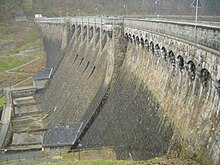Dam


Dams are systems that dam a flowing water, store water, debris , mud , drift ice or avalanche snow or serve to settle suspended matter (e.g. sand). According to DIN 19700 , which defines this term, a distinction is made between dams , flood retention basins , barrages ( weirs ), pumped storage basins and sedimentation systems .
Dams are made up of a barrier structure - dam , dam , barrage or weir - and a reservoir or reservoir . They can be located in or next to a river ( main circuit or shunt ). Other designs and parts can be found under construction of dams .
While dams block the entire cross-section of the valley beyond the cross-section of the watercourse, barrages essentially only block the river and not the entire width of the valley.
The construction and operation of dams in Germany requires a permit under water law . Depending on the type of dam, it can cause biological, chemical or physical impairment of the properties of a body of water and its floodplain . When building a new dam, the encroachment on nature and the landscape must be compensated for by suitable measures.
Floating diving walls give the impression of a dam, but allow water to flow in below and only hold back substances floating on the surface.
safety
The failure of dams, especially dam disasters , can cause enormous damage. Therefore, high demands are placed on the projects, the construction and operation as well as the control of large dams and the legislation usually prescribes comprehensive safety concepts.
literature
- DIN 4048-1 Hydraulic engineering - Terms - Dams
- DIN 19700 dam systems
Web links
- Dams in Switzerland
- Dams directory North Rhine-Westphalia (PDF; 122 kB)
swell
- ↑ Message from the Swiss Federal Council on a federal law on dams, Federal Gazette 2006 6037 , p. 6040 (public domain text; PDF; 552 kB).
